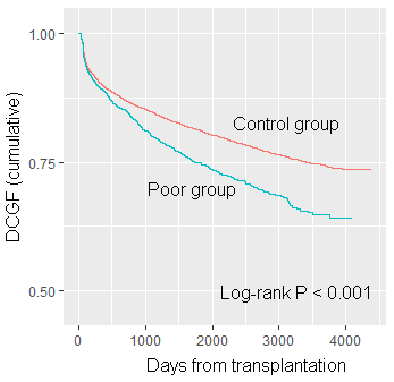Kidney Transplantation in the Lower-Income Bracket of South Korea; Widening Gap in Accessibility and Inferior Graft Outcome
G. Park1, S. Park1, J. Kim1, M. Yu1, Y. Kim1, K. Kim1, M. Park2, Y. Kim1, H. Lee1
1Seoul National University Hospital, Seoul, Korea, Republic of, 2Severance Hospital, Seoul, Korea, Republic of
Meeting: 2019 American Transplant Congress
Abstract number: 440
Keywords: Kidney
Session Information
Session Name: Concurrent Session: Kidney Psychosocial II: Substances and Access & Barriers
Session Type: Concurrent Session
Date: Tuesday, June 4, 2019
Session Time: 2:30pm-4:00pm
 Presentation Time: 2:54pm-3:06pm
Presentation Time: 2:54pm-3:06pm
Location: Room 302
*Purpose: Kidney transplant (KT) benefits in various aspects of end-stage renal disease (ESRD) patients. However, the financial burden is one of the main obstacles to receive KT. We aimed to investigate whether transplant accessibility and graft prognosis are different in a lower-income bracket.
*Methods: We reviewed the nationwide health insurance database of South Korea and identified patients who reached ESRD from the year of 2006 to 2015. The poor group was defined as those who were confirmed to have the lowest income status and to receive additional medical aid by the government, and the others were included as the controls. We investigated transplant accessibility by calculating the ratios of transplant to dialysis odds in each year of the poor people, compared to those of the control group. We also analyzed the death-censored-graft failure (DCGF) outcome of the kidney transplant recipients. Kaplan-Meier survival curve was plotted to compare the prognosis between the study groups.
*Results: We identified 70,926 ESRD cases, including 13,883 patients who received KTs. Among 10,847 poor ESRD patients, 2,109 received renal transplants. During the study period, transplant incidence increased for 2.37-fold in the control group (from 674 cases in 2006 to 1,599 cases in 2015) but it remained around 200 cases in the poor group. The transplant/dialysis odds ratios of the poor group, compared to the controls, continuously decreased during the studied period, which was an opposite trend of that of one of the income-inequality parameters in the nation (Figure 1). Moreover, the poor group showed significantly worse graft prognosis even after they received kidney transplantation than the controls (Figure 2).
*Conclusions: Accessibility to KT was decreasing in the poor people in Korea, which may be related to the increasing inequality of the nation. Additional efforts to improve graft prognosis of the poor may be necessary.
To cite this abstract in AMA style:
Park G, Park S, Kim J, Yu M, Kim Y, Kim K, Park M, Kim Y, Lee H. Kidney Transplantation in the Lower-Income Bracket of South Korea; Widening Gap in Accessibility and Inferior Graft Outcome [abstract]. Am J Transplant. 2019; 19 (suppl 3). https://atcmeetingabstracts.com/abstract/kidney-transplantation-in-the-lower-income-bracket-of-south-korea-widening-gap-in-accessibility-and-inferior-graft-outcome/. Accessed December 14, 2025.« Back to 2019 American Transplant Congress


